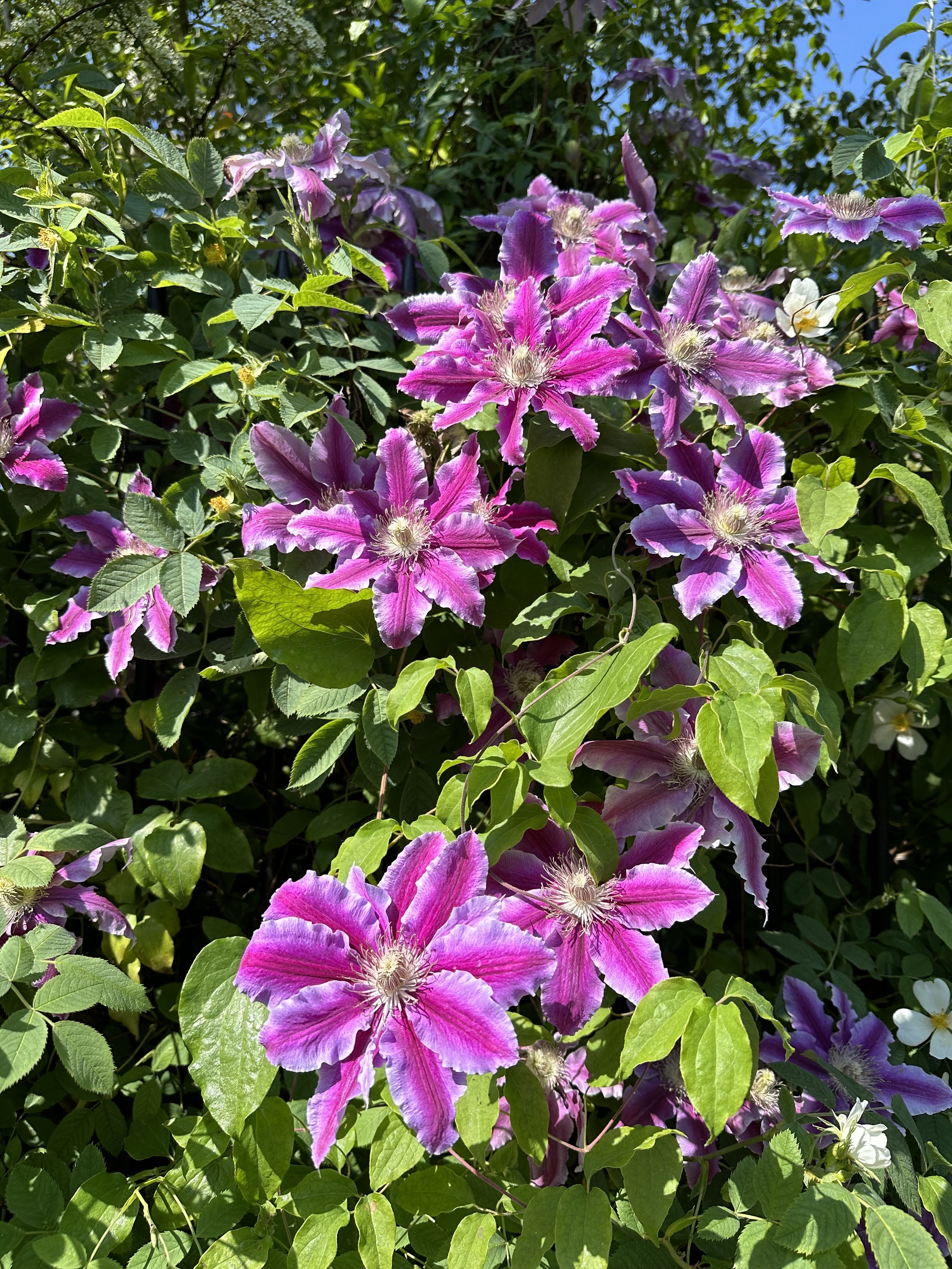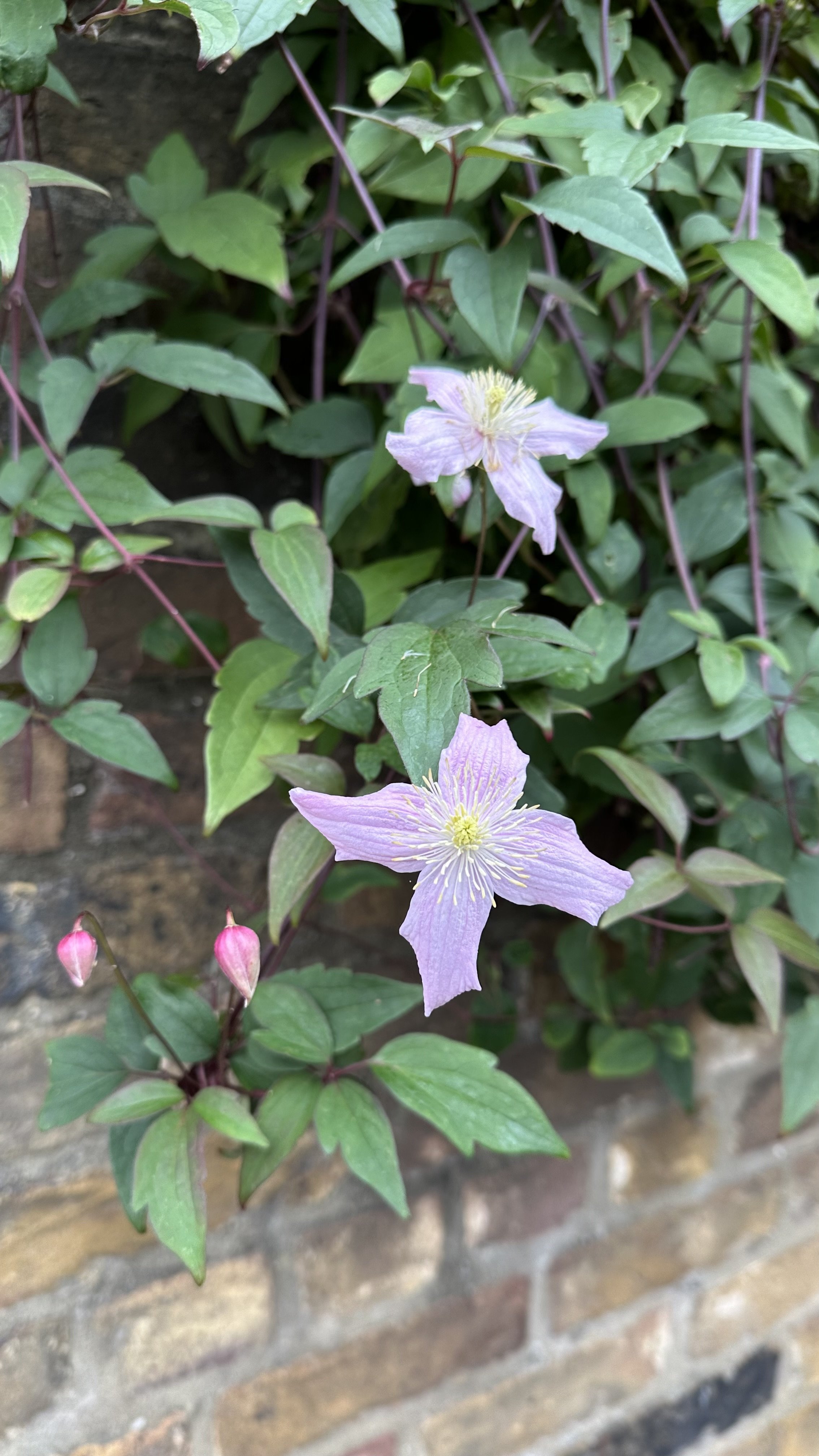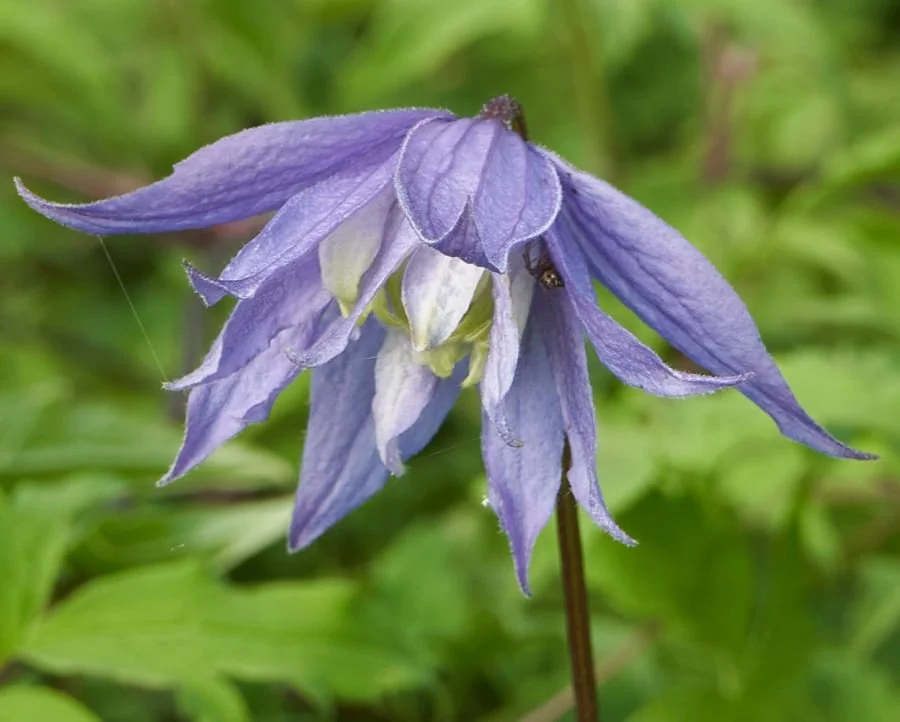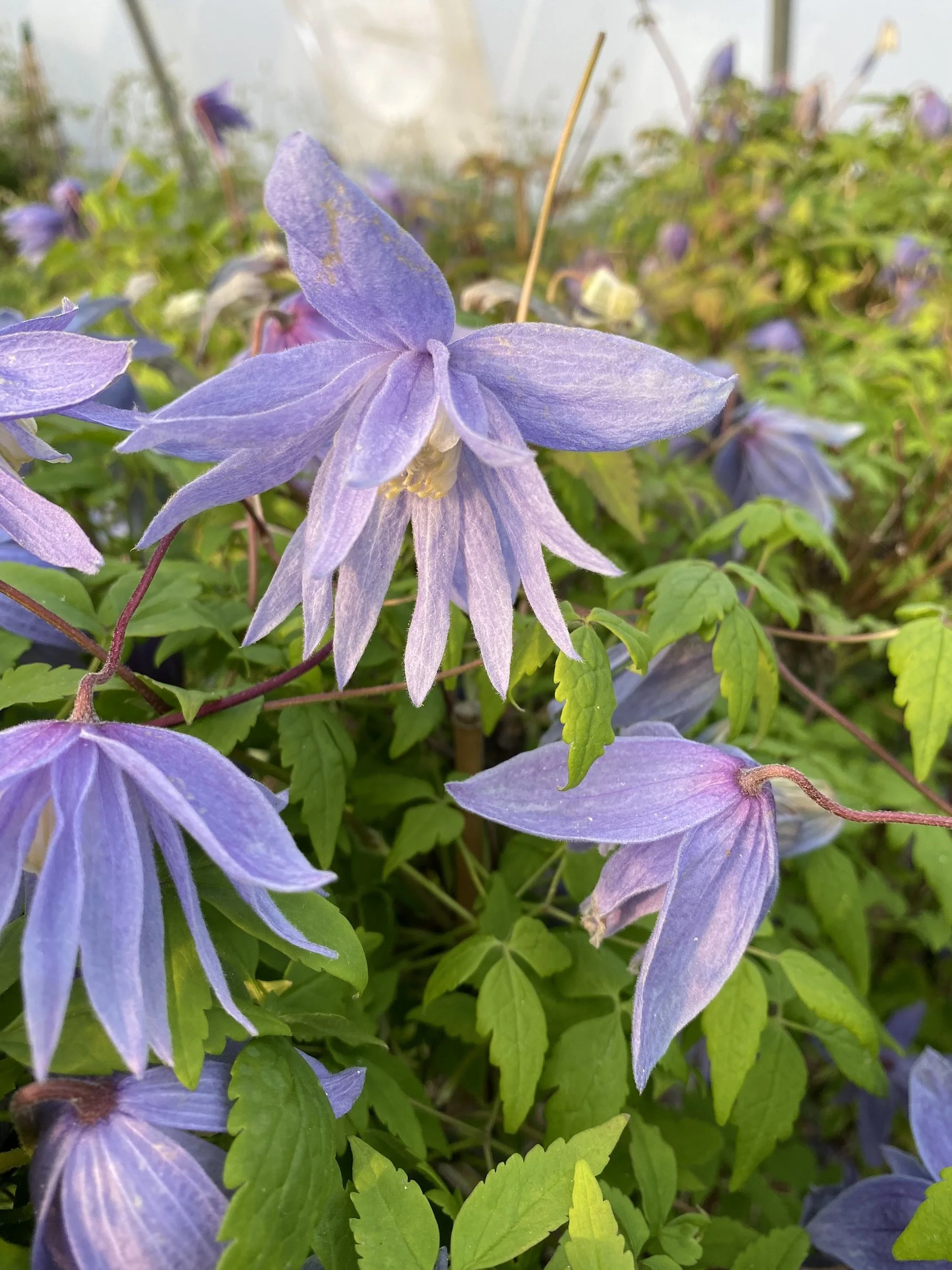Clematis for Shade: The Best Shade Tolerant Varieties
This website is reader-supported - thank you! This post may contain affiliate links. As an Amazon Associate, I earn from qualifying purchases at no extra cost to you.
If you have a shady spot in your garden, you may think that your plant options are limited.
However, there are several varieties of clematis that are well-suited for partial and full shade, making them a great choice for adding color and interest to those hard-to-grow areas.
Here we will explore some of the most popular clematis varieties for shade, including Clematis ‘Nelly Moser’ and Clematis montana, as well as tips for caring for and selecting the right clematis for your garden.
In this guide to clematis for shade I’ll help you pick the right clematis for your garden.
To learn more about growing clematis, check out my guide:
Will Clematis Grow in Shade?
Yes, many clematis varieties can be grown in partial or even full shade, although they may not bloom as prolifically as those grown in full sun.
When planting clematis in a shady spot, it's important to choose a variety that is specifically labeled as shade-tolerant, such as Clematis alpina, Clematis macropetala, or some of the larger-flowered hybrids like Clematis 'Nelly Moser'.
See below for a full list of the best clematis for shade.
It's also important to note that clematis plants that are grown in shade will generally produce fewer flowers and have a more open growth habit than those grown in full sun.
To maximize blooming, try to provide your clematis with at least a few hours of morning sun, as this will help stimulate flowering.
When planting in a shady spot, it's also important to make sure the soil is well-draining and rich in organic matter.
Clematis prefer moist but not waterlogged soil, so be sure to water deeply but infrequently to avoid overwatering.
In short, clematis can certainly be grown in shade, but it's important to choose a variety that is well-suited for these conditions and to provide the plant with the right growing environment to help it thrive.
Check out this guide for more flowering vines for shade.
Best Clematis for Shade
Clematis ‘Nelly Moser’
Clematis ‘Nelly Moser’ is a popular hybrid clematis that is known for its stunning pink flowers with distinctive pale pink stripes and bright yellow stamens.
This large-flowered clematis typically blooms from late spring to early summer and can produce flowers up to 6 inches in diameter.
Clematis ‘Nelly Moser’ is a deciduous vine that can grow up to 8-12 feet in length and is well-suited for growing on trellises, arbors, and fences.
It is also a partial shade-loving plant that prefers a cool root zone and a shady spot in the garden.
One of the reasons that Clematis Nelly Moser is so popular is that it is a relatively low maintenance plant.
It requires regular watering, especially during dry spells, and benefits from occasional fertilization with a balanced fertilizer.
It is also important to prune Clematis Nelly Moser in late winter or early spring, as this encourages new growth and helps to maintain its shape.
Overall, Clematis Nelly Moser is a beautiful and easy-to-grow clematis variety that is perfect for adding color to your garden.
Pruning:
This variety belongs to Pruning Group 2, also known as the "large-flowered" group.
Plants in this group produce their first flush of flowers on the previous year's growth, and then a second flush on new growth later in the season.
To prune, remove any dead or damaged wood in late winter or early spring, and then cut back any remaining stems to a pair of healthy buds about 6-12 inches above the soil level.
This will help to promote bushier growth and encourage more blooms.
For more tips and inspiration for your shade garden, check out my guides:
The Best Low Maintenance Shade Plants
Clematis montana
Clematis Montana, on the other hand, is a species clematis that is known for its vigorous growth and profuse blooms.
Its flowers come in shades of pink, purple, and white and are perfect for adding a splash of color to full shade areas.
Clematis montana, also known as mountain clematis or anemone clematis, is native to the Himalayas and other mountainous regions of Asia.
This deciduous clematis variety is popular for its profuse, fragrant flowers that bloom in late spring or early summer.
Clematis montana produces an abundance of small, star-shaped flowers in shades of pink, white, or sometimes purple flowers.
These flowers are typically 1-2 inches in diameter and have a pleasant, sweet fragrance that can fill the air.
The plant itself can grow up to 30 feet in length and is well-suited for growing on trellises, walls, or as a ground cover.
One of the benefits of Clematis montana is that it is a relatively low maintenance plant.
It prefers partial shade and cool, moist soil, but can tolerate a range of growing conditions.
Pruning is typically done after flowering, as this encourages new growth and helps to maintain the plant's shape.
Clematis montana is also known for its hardiness and ability to withstand cold temperatures, making it a great choice for gardeners in colder climates.
It has even been awarded the prestigious RHS Award of Garden Merit for its outstanding performance in UK gardens.
Pruning:
This variety belongs to Pruning Group 1, also known as the "early-flowering" group.
Plants in this group produce flowers on the previous year's growth, so pruning should be done immediately after flowering to avoid removing next year's blooms.
Prune lightly to shape the plant and remove any dead or damaged wood.
For more shade garden inspiration, check out my guides:
The 10 Best Flowering Vines for Shade
Clematis Alpina
Clematis alpina also known as alpine clematis, is a deciduous climbing vine that is native to the mountainous regions of Europe and Asia.
This clematis variety is known for its delicate, bell-shaped blue flowers that bloom in early spring, often before the leaves emerge.
It is a shade-tolerant plant that is perfect for growing in areas with partial shade.
Clematis alpina produces an abundance of small, nodding flowers in shades of blue, purple, or pink.
The flowers typically have four or five petals and can be up to 2 inches in diameter.
The plant itself can grow up to 15 feet in length and is well-suited for growing on trellises, arbors, or as a ground cover.
Clematis alpina is a relatively low maintenance plant.
It prefers partial shade and moist, well-drained soil, but can tolerate a range of growing conditions.
Pruning is typically done after flowering, as this encourages new growth and helps to maintain the plant's shape.
It is also known for its hardiness and for the ability of its green leaves to withstand cold temperatures, making it a great choice for gardeners in colder climates.
Overall, Clematis alpina is a beautiful and reliable clematis variety that is perfect for adding early-season color to your garden.
Pruning:
This variety belongs to Pruning Group 1, also known as the "early-flowering" group.
Plants in this group produce flowers on the previous year's growth, so pruning should be done immediately after flowering to avoid removing next year's blooms.
Prune lightly to shape the plant and remove any dead or damaged wood.
To learn more about plants that will thrive in a shady east facing garden, check out my guide:
Clematis macropetala
Clematis macropetala is another species clematis that is well-suited for shady areas.
It produces small, bell-shaped flowers in shades of blue and purple that bloom in late spring or early summer and is perfect for growing on trellises or climbing trees.
Also known as downy clematis, it is a deciduous climbing vine that is native to the mountainous regions of China and Mongolia.
Clematis macropetala produces an abundance of small, nodding flowers in shades of blue, lavender, or pink.
The flowers typically have four or five petals and can be up to 2 inches in diameter.
The plant itself can grow up to 15 feet in length and is well-suited for growing on trellises, arbors, or as a ground cover.
It prefers partial shade and moist, well-drained soil, but can tolerate a range of growing conditions.
Pruning is typically done after flowering, as this encourages new growth and helps to maintain the plant's shape.
Pruning:
This variety also belongs to Pruning Group 1, the "early-flowering" group.
Plants in this group produce flowers on the previous year's growth, so pruning should be done immediately after flowering to avoid removing next year's blooms.
Prune lightly to shape the plant and remove any dead or damaged wood.
For shady garden ideas, check out my guides:
Caring for Shade Tolerant Clematis
By following these guidelines, you can help ensure that your clematis plants are healthy, happy, and produce beautiful blooms year after year.
Planting:
Clematis prefer their roots to be kept cool, so it's a good idea to plant them in a spot where they can receive partial sun on their foliage, but shade on their roots.
Plant them deep enough so that the crown of the plant (where the stem meets the roots) is buried 2-3 inches below the soil surface.
Watering:
Clematis prefer moist soil, but not soggy soil.
Water deeply once or twice a week, depending on the weather conditions and the type of soil you have.
This is a great opportunity to use rainwater collected from a water butt.
Fertilizing:
Fertilize in the spring, as new growth emerges.
Use a balanced fertilizer or one that is specifically formulated for clematis.
Pruning:
Pruning depends on the type of clematis you have.
For early-blooming clematis, such as Clematis Montana, prune after flowering.
For later-blooming varieties, prune in the spring.
You can also prune to control the size and shape of your clematis.
Support:
Clematis are climbing plants and need support to grow vertically.
Provide a trellis, arbor, or other support structure for your clematis to climb on.
Pests and diseases:
Clematis can be susceptible to a few pests and diseases, such as spider mites, aphids, and powdery mildew.
Keep an eye out for any signs of infestation or disease, and treat accordingly.
Winter care:
Some clematis varieties are hardier than others, but most benefit from a layer of mulch around the base of the plant to protect the roots during the winter.
If you live in a colder climate, you may also want to consider wrapping your clematis in burlap to protect it from the elements.
For more flower ideas for your shade garden:
Clematis is an excellent plant to add to a shaded garden, as long as you choose the right variety for your particular conditions.
By selecting shade-tolerant varieties, planting in the right location, and providing proper care and maintenance, you can enjoy beautiful blooms from this stunning vine even in areas with limited sunlight.
Whether you're looking for a delicate pink-flowered clematis to climb up a tree or a bold purple-flowered variety to add a pop of color to your garden, there are many options to choose from.
By following these gardening tips and guidelines, you can create a gorgeous, shade-loving clematis display that will bring joy and beauty to your home for years to come.







































